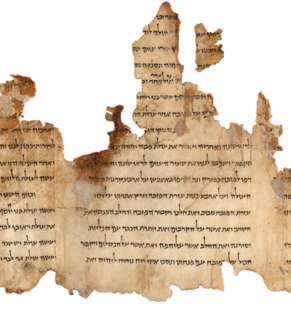| Rabbinical eras |
|---|
The House of Shammai (or Beth Shammai, or in Modern Hebrew Beit Shammai. Beth is Hebrew for house of) was the school of thought of Judaism founded by Shammai, a Jewish scholar of the 1st century, BCE. A non-literal translation that perhaps gives a better flavour of the expression would be The Academy of Shammai.

Hebrew is a Northwest Semitic language native to Israel, the modern version of which is spoken by over nine million people worldwide. Historically, it is regarded as the language of the Israelites and their ancestors, although the language was not referred to by the name "Hebrew" in the Tanakh itself. The earliest examples of written Paleo-Hebrew date from the 10th century BCE. Hebrew belongs to the West Semitic branch of the Afroasiatic language family. Hebrew is the only Canaanite language still spoken, and the only truly successful example of a revived dead language.

Judaism is the ethnic religion of the Jewish people. It is an ancient, monotheistic, Abrahamic religion with the Torah as its foundational text. It encompasses the religion, philosophy, and culture of the Jewish people. Judaism is considered by religious Jews to be the expression of the covenant that God established with the Children of Israel. It encompasses a wide body of texts, practices, theological positions, and forms of organization. The Torah is part of the larger text known as the Tanakh or the Hebrew Bible, and supplemental oral tradition represented by later texts such as the Midrash and the Talmud. With between 14.5 and 17.4 million adherents worldwide, Judaism is the tenth largest religion in the world.

Shammai was a Jewish scholar of the 1st century, and an important figure in Judaism's core work of rabbinic literature, the Mishnah.
Contents
The House of Shammai was the most eminent contemporary and the halachic opponent of the House of Hillel and is almost invariably mentioned along with him. Both Houses are mentioned in the Talmud, where all of the discussions between the houses are listed, including some stories. It is the eighth most frequently mentioned in the Mishnah. [1]
Halakha is the collective body of Jewish religious laws derived from the written and Oral Torah. Halakha is based on biblical commandments (mitzvot), subsequent Talmudic and rabbinic law, and the customs and traditions compiled in the many books such as the Shulchan Aruch. Halakha is often translated as "Jewish Law", although a more literal translation might be "the way to behave" or "the way of walking". The word derives from the root that means "to behave". Halakha guides not only religious practices and beliefs, but also numerous aspects of day-to-day life.
The House of Hillel, was a school of Jewish law and thought founded by Hillel the Elder which thrived in 1st century B.C. Jerusalem. The House of Hillel is most widely known for its hundreds of disputes with the House of Shammai, founded by Shammai, a contemporary of Hillel's. Most of the disputes between the two schools involve Halakha ; however, some involve arguments of Jewish philosophy.

The Talmud is the central text of Rabbinic Judaism and the primary source of Jewish religious law (halakha) and Jewish theology. Until the advent of modernity, in nearly all Jewish communities, the Talmud was the centerpiece of Jewish cultural life and was foundational to "all Jewish thought and aspirations", serving also as "the guide for the daily life" of Jews.
Fur a full discussion of the differences between the Houses of Hillel and Shammai, see Houses of Hillel and Shammai .
The House of Hillel and House of Shammai were two schools of Jewish scholars during the period of tannaim, named after the sages Hillel and Shammai who founded them. These two schools had vigorous debates on matters of ritual practice, ethics, and theology which were critical for the shaping of the Oral Law and Judaism as it is today.




